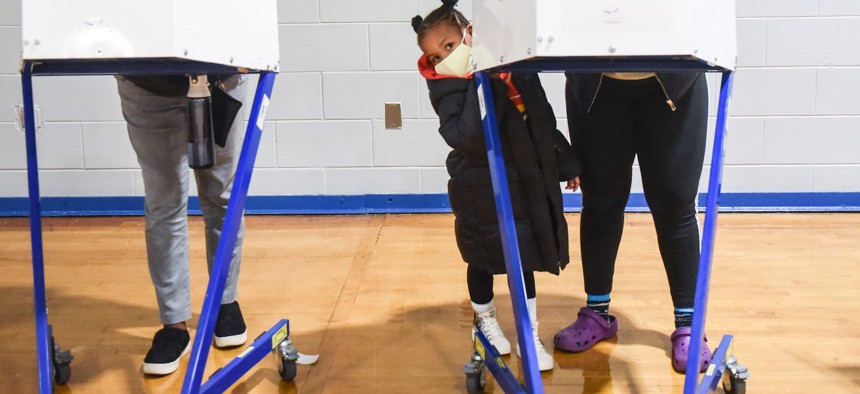Forget Election Day, it’s Election Week! Election Month! Who knows when we’ll have definitive results in the presidential election as the counting continues, not to mention other close races across the nation and here in New York. Just as the Queens district attorney race last year was an eye-opening experience about the painstaking process of counting ballots and parsing the ensuing court battles, it seems the presidential election is opening the eyes of voters across the country to the inner workings of elections administration. So go brew some more coffee and keep reading for the latest news.
Election night and slow results
After nine days of early voting, record absentee ballots cast and traditional Election Day voting, the outcome of many races in New York remained uncertain. Nationally, the presidential election dragged on for days and as of Friday morning, neither candidate has been declared the victor. Still, former Vice President Joe Biden appeared to be inching closer to 270 electoral votes, and President Donald Trump’s path to victory appeared to be narrowing. Trump repeatedly made unsubstantiated and dangerous claims about voter fraud, saying that he easily won if only “legal votes” were counted and claiming that Democrats were attempting to steal the election. He continued to undermine the integrity of the election at a White House briefing on Nov. 5 while demanding that vote counting stop in states where he was leading and continue in states where he was losing. Trump said he plans to ask the U.S. Supreme Court to intervene, though his campaign has already filed several lawsuits in key battleground states. In New York, which Biden won easily, Republicans took early and strong leads in several competitive congressional races against Democratic incumbents. Notably, Assembly Member Nicole Malliotakis declared victory over Rep. Max Rose on Staten Island. Although there were still tens of thousands outstanding absentee ballots, Malliotakis’ lead seemed to be nearly insurmountable. Upstate, Claudia Tenney was well positioned to defeat Rep. Anthony Brindisi, who unseated her two years ago. And on Long Island, Assembly Member Andrew Garbarino was poised to defeat Democrat Jackie Gordon, who was thought to have a solid chance at winning. The majority of competitive races were too close to call on election night due to the more than 1.5 million absentee ballots that have been received by the state.Republicans also took early leads in state legislative races against Democratic incumbents, including against state Sens. Andrew Gounardes in Brooklyn and Monica Martinez in Suffolk County. Most trailing Democrats expressed optimism that mail-in ballots would put them over the top in the end. In Western New York, however, three Democrats – Samra Brouk, Jeremy Cooney and Assembly Member Sean Ryan – declared victory in their state Senate races, flipping open seats previously held by Republicans. Although Cooney and Brouk enjoyed only slim leads on election night, Ryan’s lead was much more commanding. Although the final results in many races remained in doubt, Gov. Andrew Cuomo essentially blamed New York City Mayor Bill de Blasio for what appeared to be Republican gains in the state, saying that the GOP successfully fearmongered about New York City due to de Blasio’s mismanagement. Cuomo did not acknowledge that bail reform, which passed at the state level, was one of the main issues used by Republican candidates in their races. Cuomo also said he felt confident that the state would legalize recreational marijuana next year, since New Jersey voters just approved legalization.
Protests after Election Day
Although election night itself was relatively calm, protests the next two days led to violent confrontations with police in New York City and dozens of arrests. The New York City Police Department was out en masse both nights in order to respond to planned protests and marches that were largely peaceful. On the first night, protesters and journalists reported that the NYPD engaged in the controversial practice of kettling, in which officers essentially trap demonstrators in a small space after forcing them to move toward a police line while at the same time preventing them from retreating. According to reports, officers did not allow protesters to disperse before beginning to make arrests. The next day at a press conference, NYPD Chief of Patrol Juanita Holmes denied that officers had ever kettled protesters and said she had never heard that term until recently. On the second night of protests, video showed police pushing New York City Public Advocate Jumaane Williams.
Coronavirus on the rise in New York
As the number of coronavirus cases continue to rise in many states, New York’s numbers were comparatively low but also increasing. In Western New York, the positivity rate hit 3% on Nov. 2, and in Erie County specifically, the number of daily deaths were the highest they have been in months as infections among school staff and children ticked up. The county also saw a concerning one-day positivity rate of 5%. The governor’s current strategy of attacking outbreaks didn’t apply to Western New York as specific ZIP codes were not experiencing incongruous spikes. Lt. Gov. Kathy Hochul said a regionwide shutdown was not in the cards, despite having the worst numbers since the peak of the pandemic. Meanwhile, Nassau County on Long Island reported its highest number of new cases since May, as the island’s positivity rate hit 2%. Meanwhile, New York City identified two new Staten Island ZIP codes experiencing an increase in COVID-19 cases, while Suffolk County was monitoring clusters of cases related to an early voting location and a school district. Statewide, the rate of positive cases was the highest it had been since June and inching closer to 2% as Cuomo said increased hospitalizations was “a caution flag.”


